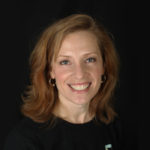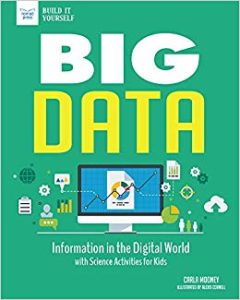“Big Questions, Big World, Big Data!”
Did you shop online today? Write an essay in Google docs? Send a snapchat to a friend? If so, you’ve been using data!
Data is a collection of small bits of information. It’s what we know and can measure about the world. Data has been around since people could count and write down their observations, which means we’ve been creating and using data for many centuries.
Now, because of computers and the internet, the amount of digital data in the world is vast. There’s so much data, we’ve taken to calling it “big data!” People generate data every day. When we shop, when we listen to music online, when we use fitness trackers, when we text, when we simply visit different websites—all of these actions generate data about who we are and what we like.
But…why? Great question. Many organizations and businesses use data in innovative ways to help create new products and processes that improve the quality of life for people around the world. Others have used data for financial gain. Data can be used for many different purposes.
But there are problems. How do we store all of that data? How do we access it when we need it? How do we know what is good, trustworthy data and what is bad data? And what about keeping things private? Not everyone wants the world to know where they shop or what they eat or how much money they have in the bank. How do we make sure that our data isn’t being accessed when we don’t want it to be, or used in ways that are harmful?
These are critical questions that lots of different people are working on finding the answers to. The first, very important step is to understand what exactly data is, how it works, how we collect, store, and access it, and how we can protect it.
Try these hands-on projects to start thinking about data!
WHERE’S THE DATA?
Data can be found everywhere in the world. You generate data about yourself everyday—at home, at school, at work, and with your friends. In this activity, you will collect data about yourself and others. Then you’ll use the data you have collected to create meaningful information.
To start, find a partner—a classmate, friend, or family member—who is willing to participate in the activity with you. Together with your partner, brainstorm sources of data about each of you. Here are some ideas for data sources.
What data can you discover about a person from their cell phone?
What data can you discover about a person from their computer history?
What data can you discover about a person from their schedule and activities?
What can you discover from social media sites?
Now that you’ve identified several sources of data, you and your partner should select three sources from which to collect data about the other person. Decide how you are going to record or log this data—by hand, in a spreadsheet, or in a Word document. Collect and record your data.
Once you have three data sets about your subject, what can you do with the raw data? Is it meaningful in its raw format? Why or why not?
How can you organize the data so that it is more useful? What information can you learn from the data you have collected? For example, can you use the data to discover your partner’s favorite hobbies, websites, or television shows? What does this tell you about your partner? Is this information accurate?
Consider This!
As more devices collect data about your activities online and offline, what issues do you think this could cause? Who sees and owns this data? What should they be allowed to do with the data? What restrictions should be put in place?
EXPLORE WEATHER DATA
What’s the weather like where you live? Weather is one type of data in the world around you. It can be measured and described in many ways, including temperature, rainfall, wind speed, and humidity levels. Every measurement is a piece of data that can be used in a variety of ways.
To start, you’ll need to select two cities along with your own city. You will be collecting weather data for all three cities during a two-week period.
Every day for two weeks, use the internet and local weather sources to collect weather data. Consider collecting the following types of data.
Temperature, both high and low
Wind speed
Wind direction
Air pressure
Sky conditions– sunny, cloudy, partly cloudy
Precipitation–type and amount
Humidity
Meteorologists and other scientists use graphs and charts to look for trends in data. Create graphs for each category of weather data to compare and contrast the data from the three cities.
Now that you have organized your weather data, you can analyze it for useful information about the weather in the three cities. Use the graphs and charts to think about the following questions.
How would you describe the temperature changes in each city?
What was the highest and lowest temperature in each city and when did it occur?
What was the average temperature in each city?
Which city had the most sunny days, cloudy days, and rainy days?
Is there a relationship between sky conditions and temperature?
Is there a relationship between wind direction and temperature?
Which day had the most precipitation? Which had the least?
What was the total precipitation for the two-week period in each city?
How did air pressure change in each city? Did you spot any trends?
Is there a relationship between air pressure and the sky conditions of the next day?
Data can help us better understand the world around us. How are you able to use the data you collected to better understand the weather in your city and the other cities you tracked? What can you do with this information?
Try This!
How can you use your weather data to predict future weather? Based on the graphs and data analysis that you completed in this activity, what information have you learned that could help you predict weather in your city?
LEARNING ABOUT COMPUTER HISTORY
Many people, discoveries, and milestones were part of the history of the computer. From counting on an abacus to designing the first computer game, many people had a role in creating the technology behind today’s computers. In this activity, you’ll have the chance to learn a little more about a person or discovery you find especially interesting.
To start, think about an area of computer and data history that you want to learn more about.
You can pick a topic from this list, browse through the Computer History Museum’s website for ideas, or choose one of your own.
Abacus
Charles Babbage and Ada Lovelace
Hollerith’s punched cards
Grace Hopper
Colossus computer
The six ENIAC programmers
First IBM personal computer
Apple Macintosh
Microsoft Windows
Google search engine
Using the internet and your library, research your chosen topic. Why is your topic important? What problem did it solve? How did it contribute to computer history?
Create a short video or PowerPoint presentation to share what you learned.
Consider This!
What is the connection between the topic you chose and how we collect, store, and use data today? How did this discovery or person in computer history impact the world of data today?
About the Author: Carla Mooney has written more than 70 books for children and young adults. Her work has appeared in many magazines including Highlights, Faces, and Learning Through History. Carla lives in Pittsburgh, Pennsylvania.
Website: carlamooney.com
Facebook: facebook.com/carlamooneyauthor
Big Data: Information in the Digital World with Science Activities for Kids
Published August 3rd, 2018 by Nomad Press
About the Book: Have you watched videos online today? Did you post photographs on social media? Did you upload your English essay to Google docs? All of these are questions about data!
In Big Data: Information in the Digital World with Science Activities for Kids, readers ages 10 to 15 explore the definition of data and learn how essential it is to our everyday lives. They learn about the history of data, the transition from paper to computers, and the role that search engines such as Google play in handling data. By making connections between the relationships among data, computers, and people, middle school kids also acquire the tools they need to become better digital citizens!
Thank you to Carla and Nomad Press for this great post with perfect activities for any STEM/PLTW/ICT, etc. classroom!


